Wagyu around the World - Australia
History of Wagyu in Australia
The introduction of Wagyu cattle to Australia involved live imports through USA as there is no protocol for direct imports from Japan. The 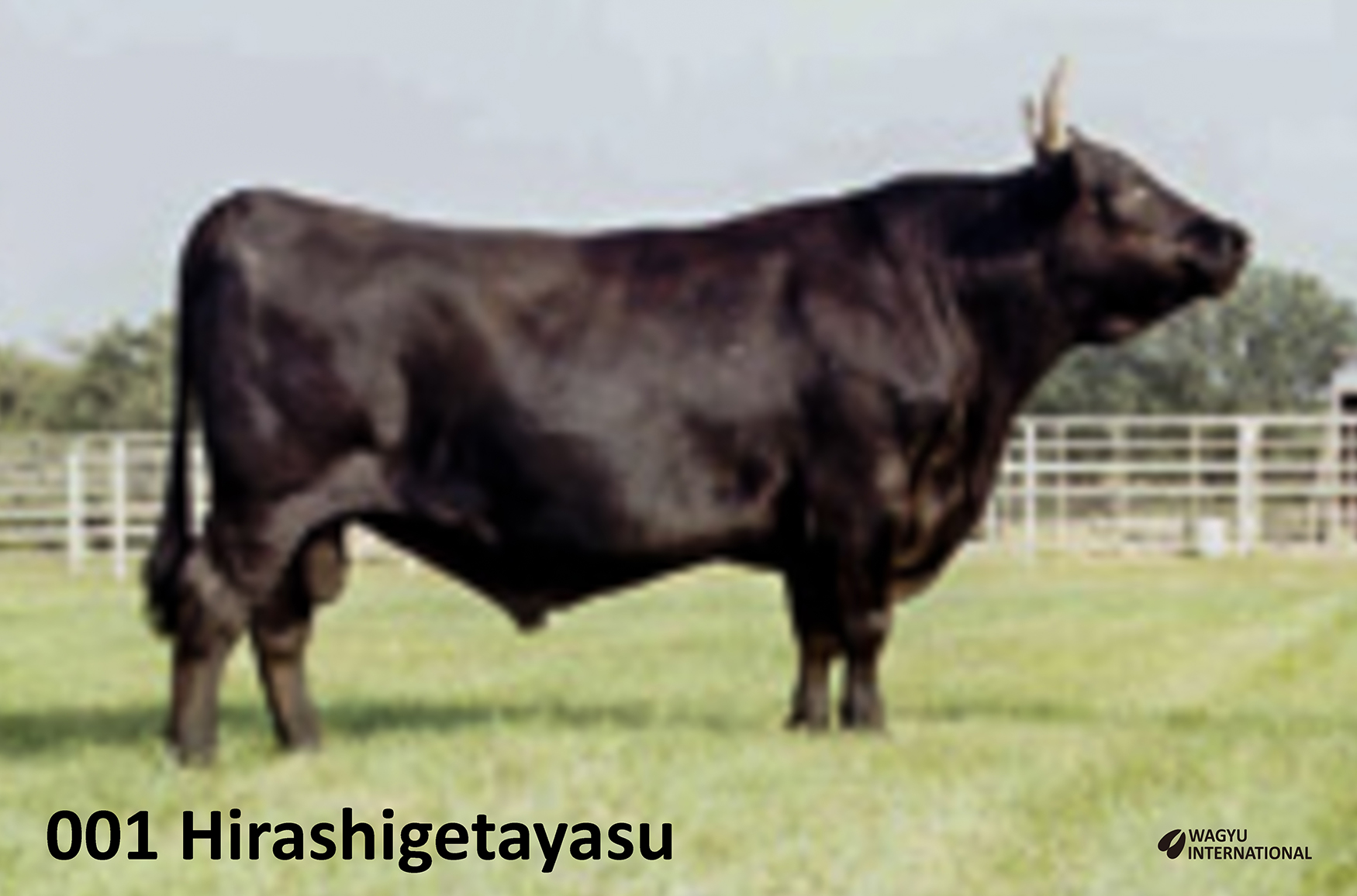 first Wagyu imports to USA were four bulls in 1976 and they were mated to females of other breeds. Three generations of crossing back to Wagyu is required to produce American purebred progeny which comprise 93.75% Wagyu (15/16). Purebred semen, embryos and one female were imported to Australia.
first Wagyu imports to USA were four bulls in 1976 and they were mated to females of other breeds. Three generations of crossing back to Wagyu is required to produce American purebred progeny which comprise 93.75% Wagyu (15/16). Purebred semen, embryos and one female were imported to Australia.
A shipment of five fullbloods (100% Wagyu) was exported from Japan to the United States in July 1993. These included the two bulls; 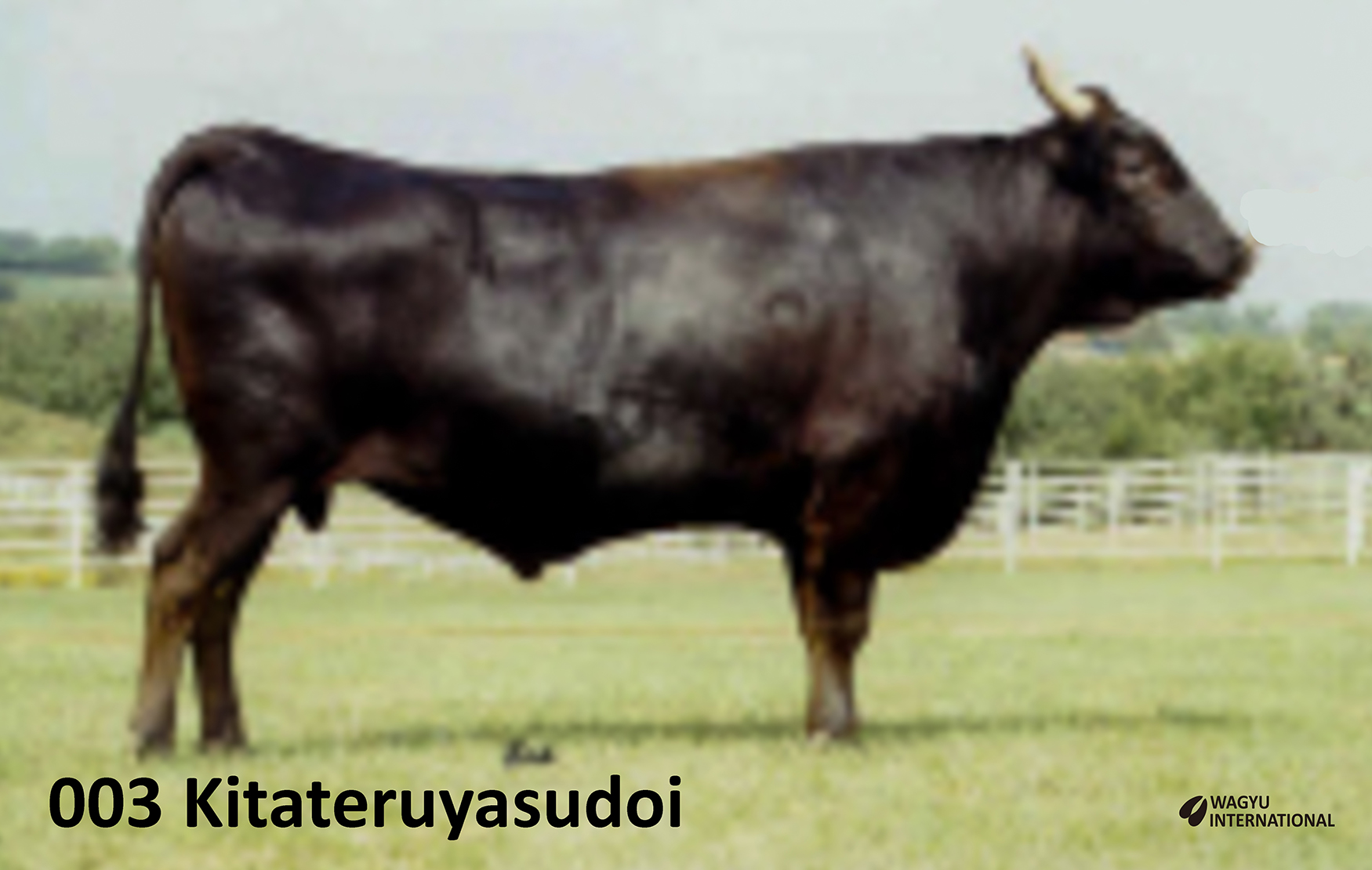 Michifuku and Haruki 2, and the four heifers; Suzutani, Rikitani and Okutani. These cattle were followed by three further shipments of live cattle. In 1995, there was a major shipment from the famed Takeda stud of Mr Shogo Takeda. The Takeda shipment comprised 35 heifers with some in calf and 5 bulls. Four of those bulls qualified for semen shipment to Australia. Another 45 black females and six black bulls were imported from Japan to USA in 1996.
Michifuku and Haruki 2, and the four heifers; Suzutani, Rikitani and Okutani. These cattle were followed by three further shipments of live cattle. In 1995, there was a major shipment from the famed Takeda stud of Mr Shogo Takeda. The Takeda shipment comprised 35 heifers with some in calf and 5 bulls. Four of those bulls qualified for semen shipment to Australia. Another 45 black females and six black bulls were imported from Japan to USA in 1996.
Chris Walker of Westholme imported 25 black females and three black males to USA. The following year another 59 females arrived in USA together with semen from three black bulls - Dai 6 Seizan, Kitatsurukiku Doi and Shigefuku. The three imported bulls were slaughtered after the outbreak of BSE in Japan but the autopsies confirmed that they are free so the semen that had been stored is available. Their  semen - Hirashigetayasu "001" (Kedaka), Itomoritaka "002" (Fujiyoshi) and Kitateruyasu Doi "003" (Tajima) - has contributed largely to size in the Australian herd from milk and growth because of the diversity and Kitateruyasu Doi contributes high marbling. The females were exported to Australia and also brought diversity from 44 Shimane, 28 Kedaka and 12 Tajima. Dams which bred in Australia include: Hatsuko, Itoreiko, Kazuaki, Kitahikari 97/1, Kitakazu, Kitaokumi, Kitasakaedoi, Kitasekitori, Kitatizuru 2, Kunikiku 96, Masako, Masatoshi 2, Sakaehikari, Sekinakada 22, Sekiyuhou, Takakuni, Takashigedoi, Yamafuji, Yamaketakafuji 3 and Yuriyuho.
semen - Hirashigetayasu "001" (Kedaka), Itomoritaka "002" (Fujiyoshi) and Kitateruyasu Doi "003" (Tajima) - has contributed largely to size in the Australian herd from milk and growth because of the diversity and Kitateruyasu Doi contributes high marbling. The females were exported to Australia and also brought diversity from 44 Shimane, 28 Kedaka and 12 Tajima. Dams which bred in Australia include: Hatsuko, Itoreiko, Kazuaki, Kitahikari 97/1, Kitakazu, Kitaokumi, Kitasakaedoi, Kitasekitori, Kitatizuru 2, Kunikiku 96, Masako, Masatoshi 2, Sakaehikari, Sekinakada 22, Sekiyuhou, Takakuni, Takashigedoi, Yamafuji, Yamaketakafuji 3 and Yuriyuho.
Simon Coates had been exporting F1s from purebreds to Japan since he formed Sumo Wagyu in 1991. After quarantine conditions had been met for the first shipment of Shogo Takeda's Foundation sires and heifers to USA, Simon exported 56 calves from six families as embryos from Mr Takeda in USA in deliveries in 1996 and 1997 to Australia. He subsequently purchased the Takeda herd in Australia:
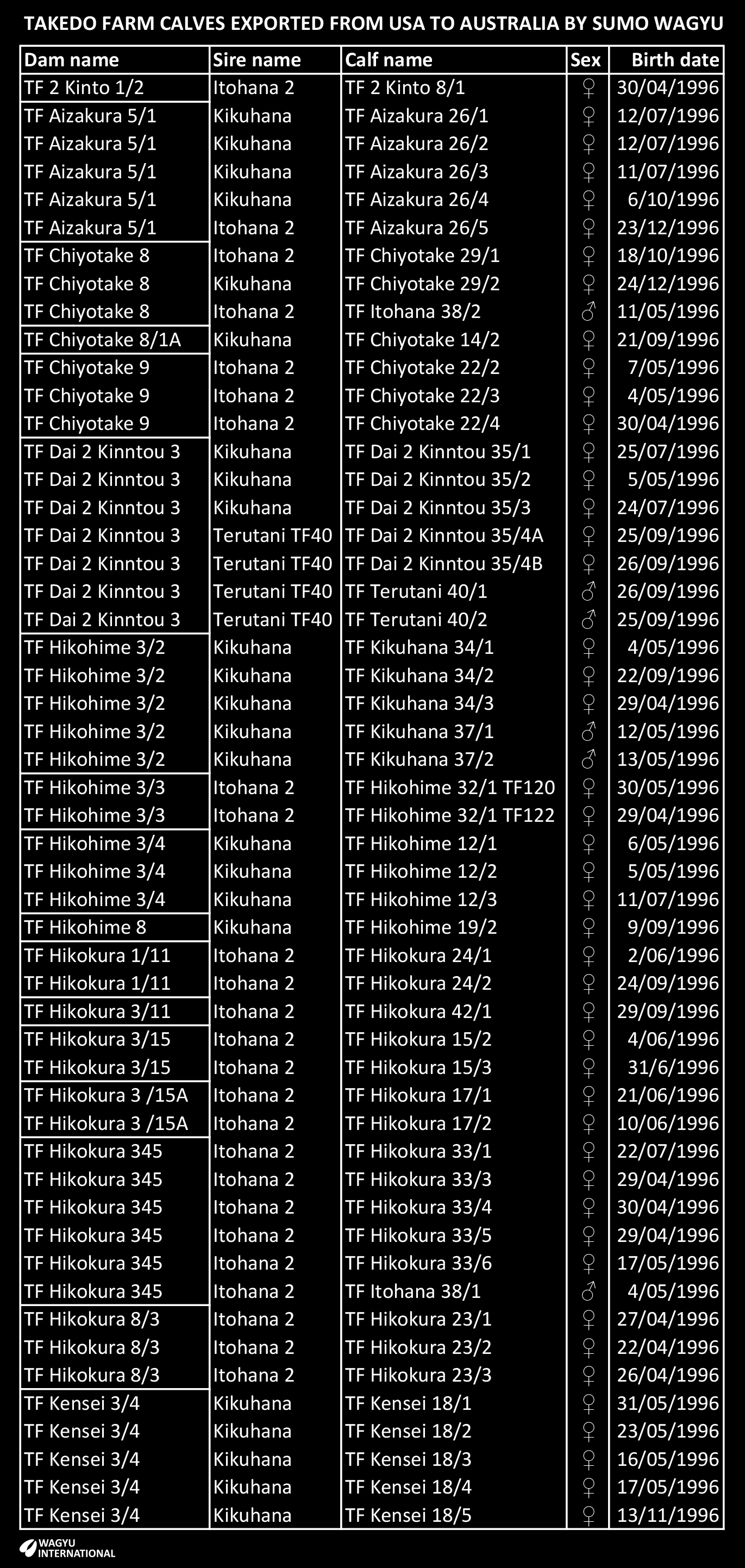
Additional shipments of live Wagyu were consigned from USA to Australia and they supplemented the embryos and semen that had already been imported. Included in these was the export to Australia by Mannett/World K's of 16 Wagyu bulls and three Wagyu heifers from USA.
The performance of the initial USA purebred imports to Australia were considered to be inconsistent so many Australia breeders converted to fullblood Wagyu when they became available from USA.
More than 96% of registrations are of Black Wagyu. Red Wagyu have proved popular with northern commercial producers who have recognised their fertility and higher frame score over the blacks in addition to Wagyu carcass traits. Red Wagyu are being incorporated into composite herds.
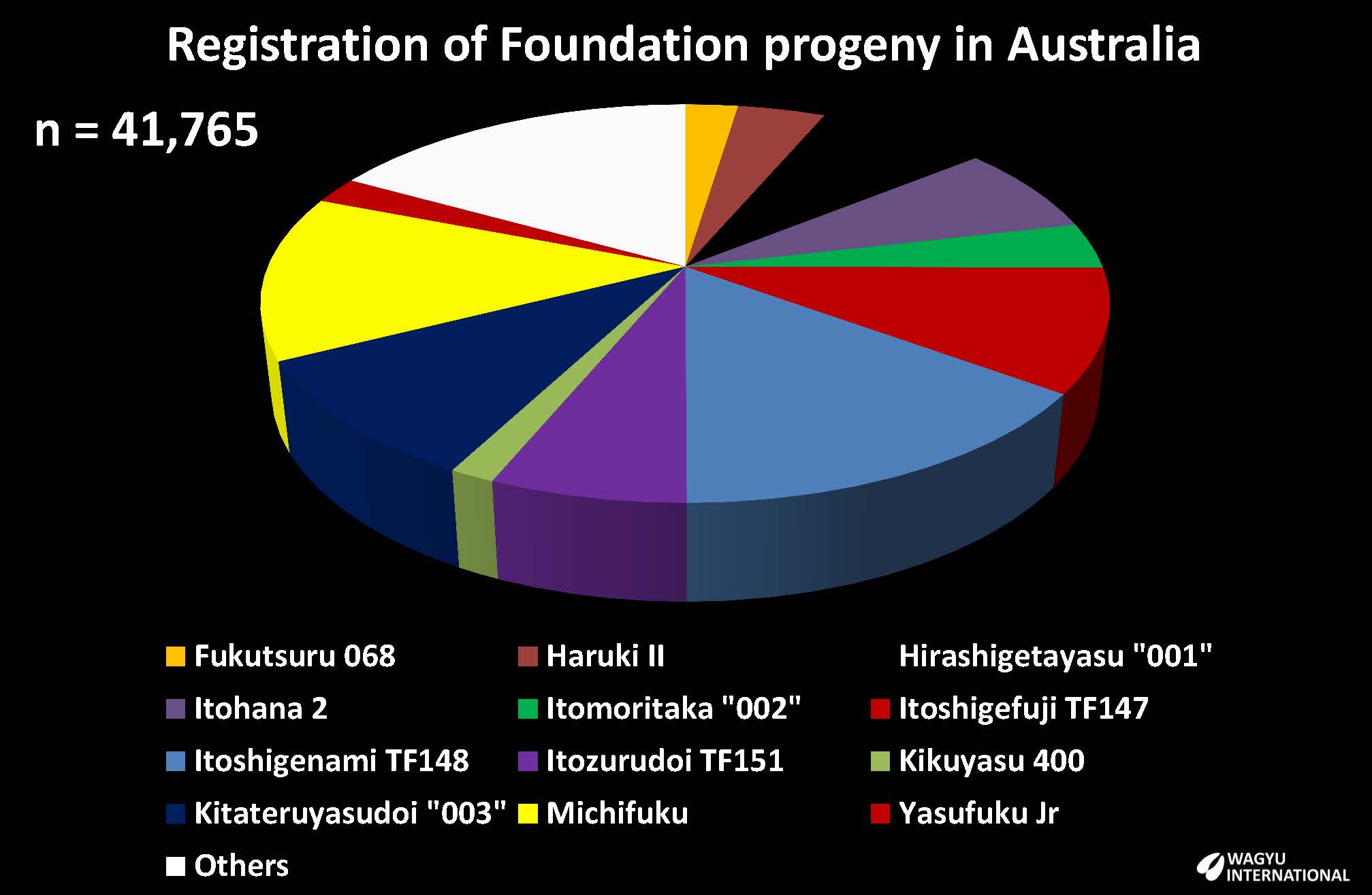
Population and production
Wagyu production is valued at AU$2 billion in Australia. The breed association estimates that there is more than 300,000 Wagyu cattle on feed in 2022 in Australia, for processing next year – up from around 260,000 last year.
“That’s a 15pc increase in just 12 months, and continues a longer-term trend, driven by global marbled beef demand.”
Around 30 percent of feedlot capacity across the country is currently occupied by Wagyu cattle – ranging from F1 on 380-400 day programs and Fullbloods on F1s to 450-500 days.
15 000 head are exported live within Asia.
90% of locally processed Wagyu product is exported to more than a dozen countries.
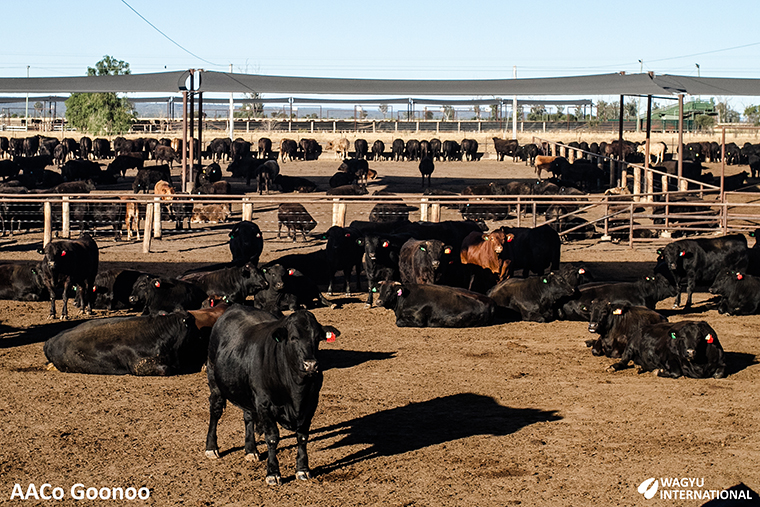
Grading
The following standard measurements are recorded for MSA grading:
- Body number and lot number
- Carcase weight
- Sex – male or female
- Tropical breed content – the hump height is measured
- Hanging method is either Achilles hang or tenderstretch
- Hormonal growth promotants
- Ossification – measured to determine carcase maturity
- Marbling– using both the MSA and AUS-MEAT measurement systems from between the 5th to 13th rib.
- Rib fat – a minimum of 3mm is required, measured at the AUS-MEAT standard site. Overall fat cover is also assessed including any hide puller damage
- pH and temperature
- Meat colour
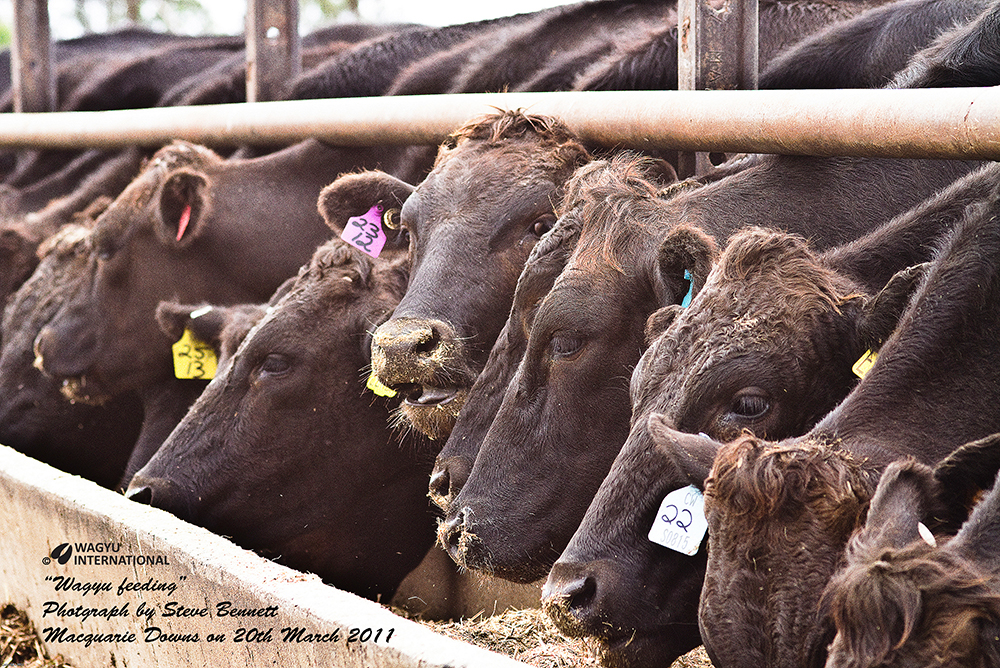
The following readings can be taken when requested:
- Eye muscle area (EMA)
- Fat colour
When all the specifications are met and the cuts can grade under MSA, a carcase is scored "0". If the carcase does not meet all the specifications it is given a grade code which indicates which of the specifications were not met. They number from 1 to 9 (Meat Standards Australia).
The language and descriptors used in the Australian beef industry is currently under review.
MSA is based on quality and there has been increased uptake annually. The largest retailer Woolworths adopted MSA as their standard in 2012 and presently there are more than 100 MSA licensed brands across Australia. The number of carcasses graded to MSA exceeded 3 million in the year ending 30th June 2014.
Marbling grade and Wagyu
Ten years ago, image analysis data was compared with AUS-MEAT grading. Pure (100%) Wagyu averaged 6.8 AUS-MEAT marbling score. F1 (50%) Wagyu scored significantly (P < 0.01) lower with 4.7. There is a high correlation between Fullblood and F1 for both systems (r = 0.88) except that AUS-MEAT marbling score has an inadequate range of values to evaluate high marbling breeds such as Wagyu. 30% of pure Wagyu were scored in the top AUS-MEAT marbling score of 9 so many exceed it. This limitation makes the use of marbling percentage from image analysis more crucial in determining marbling of Black Wagyu. Heritability of marbling using imaging is 0.54. This is higher than the heritability of 0.23 from AUS-MEAT marble score (Maeda et al., 2013). 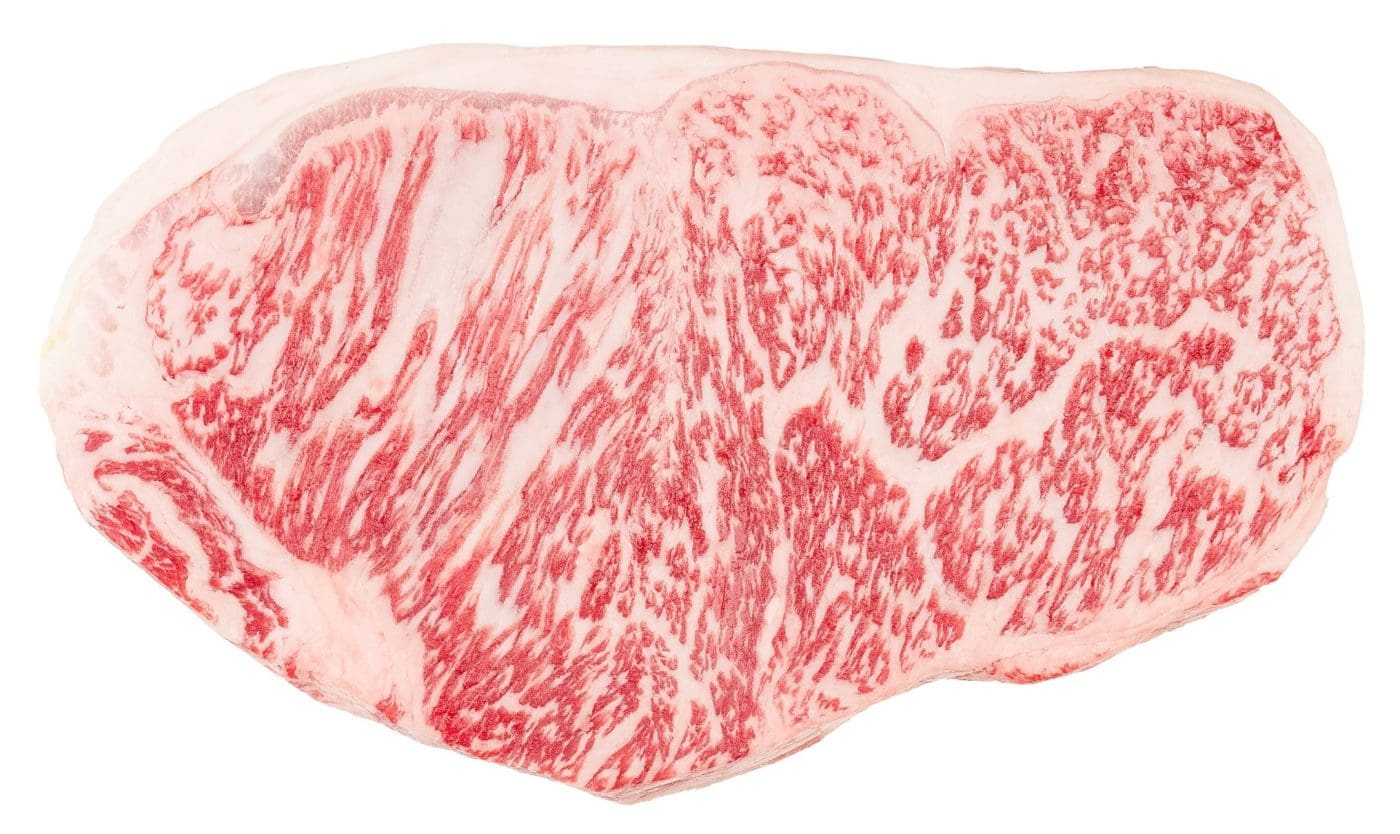
The MSA marbling system provides an additional indication of distribution and size (Meat Standards Australia). There is a finer scale from 100 through to 1,190 and Wagyu carcasses attain the highest level.and beyond.
The AWA Branded Beef competition is the premier event in Australia with striploins worth AU$2,000. A panel of 36 judges evaluated taste for the April 2024 event and algorithims were recorded from the MIJ and NIX cameras, infra-red spectroscopy, fatty acid analysis and 100K SNP chip. The highest intramuscular fat content of 65% equalled the highest fat content in the most recent competition but highest score for its class a was awarded to a 58% IMF entry. In Japan the average IMF% for BMS 12 is 63%. A fat ratio that is above 50% will become less common in Japan when the mandate to process at a younger age in order to reduce quantities of imported feed. The western palate is not accustomed to excessive fat or the taste becomes 'greasy' and Australians like sufficient muscle to chew.
Some scores from winners of each class in Sydney in April 2023 are tabled:
| Class | IMF% | Fineness | EMA | Winner |
| Fullblood & Grand Champion | 58 | 8.6 | 109 | Kilcoy |
| Purebred | 61 | 7.0 | 97 | Jacks Creek |
| F1 | 57 | 7.4 | 98 | Andrews |
| Crossbred | 29 | 5.7 | Pardoo | |
| Commercial MS 5-7 | 32 | 5.8 | 94 | Stanbroke |
Minimum intramuscular fat % is documented for Marble grades in Japan, Australia and USA and these are charted. The use of digital imaging of carcasses during processing enables the IMF% to be determined within each BMS and AUS-MEAT marble grade in Japan and in Australia. There can be 20% variation within each marble score and when the vagaries of domestic grading by eye is overcome by the use of digital imaging, heritability of marbling is almost doubled. Another constraint is that 30% of Fullblood Wagyu grade higher than the highest AUS-MEAT and MSA marbling grades.
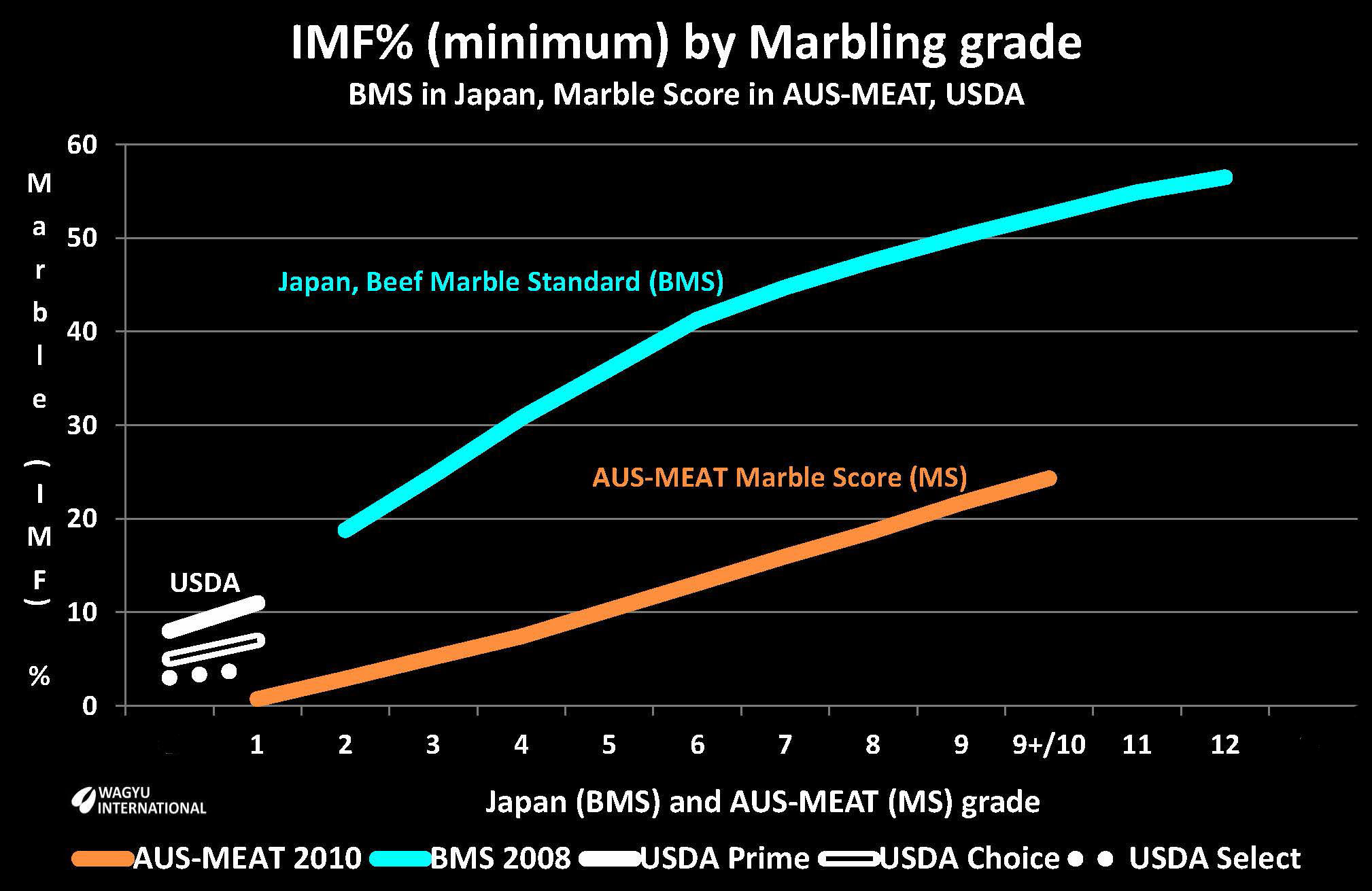
Several producers that I have spoken to, especially overseas, have the wrong understanding of the avearge IMF% in each country. They quote the minimum level of 20% for AUS-MEAT Marble Scoree 9 in Australia to be the "average" from the works. In fact, from digital imaging, the average IMF% in Australia is 31%. The range is from 20 to 47%.
This wide range of about 20% for each marble score is illustrated in the chart below from the Obihiro University camera in Australia and Japan:
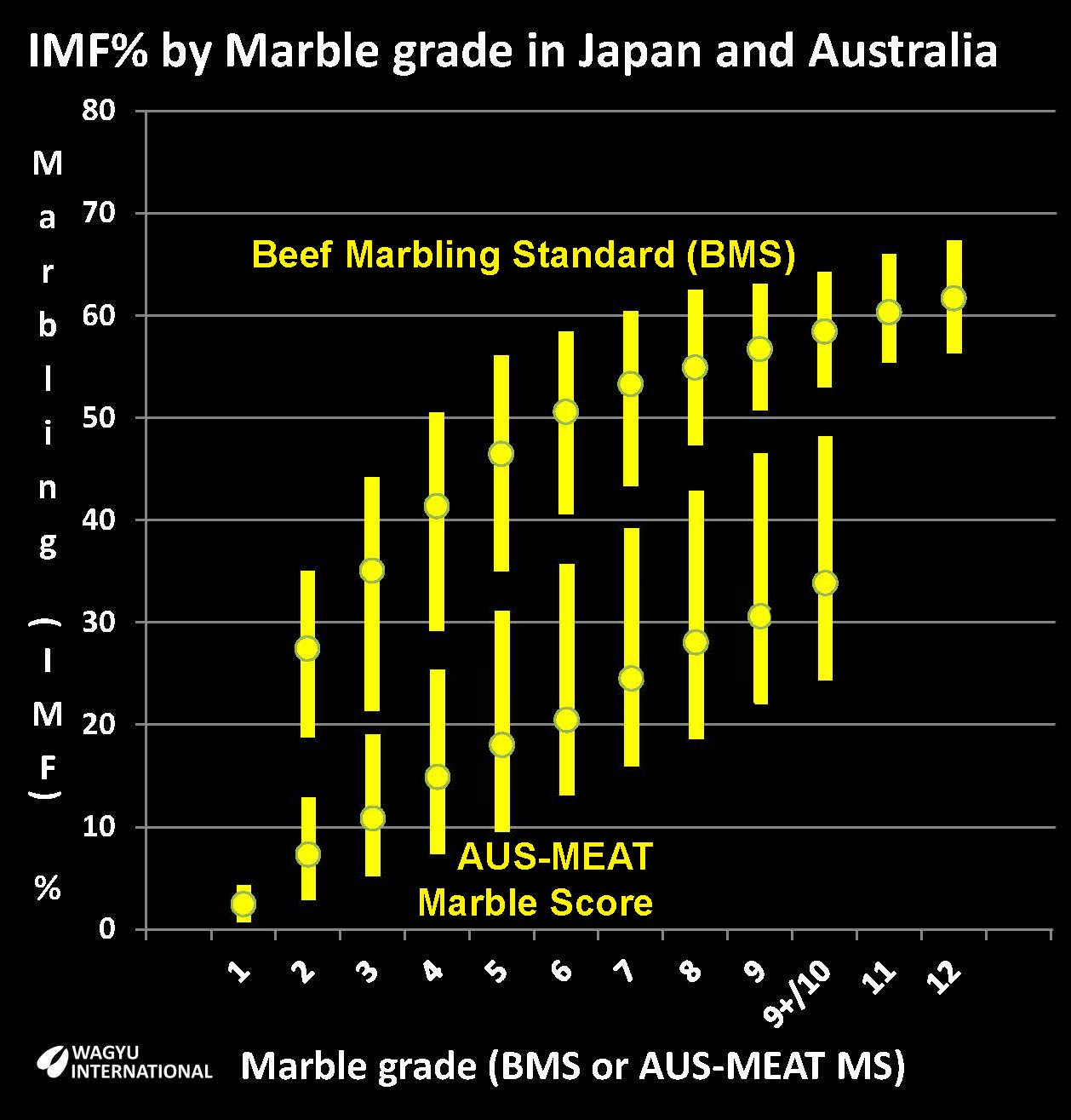
The average IMF% is virtually 20% higher in Japan (BMS) for the same number grade in Australia ( AUS-MEAT Marble Score or MS). For example, BMS 9 in Japan has an average IMF% of 57%, while AUS-MEAT marble score 9 has an average IMF% of 31%. Therefore it is misleading and deceptive to refer to marble score in Australia in promotions and sales as 'BMS' instead of 'AUS-MEAT Marble Score'.
| Grade | BMS (Japan) | MS (AUS-Meat) |
| 2 | 27% | 8% |
| 3 | 35% | 11% |
| 4 | 42% | 15% |
| 5 | 47% | 19% |
| 6 | 51% | 21% |
| 7 | 53% | 24% |
| 8 | 55% | 26% |
| 9 | 57% | 31% |
| 9+/10 | 58% | 34% |
| 11 | 61% | |
| 12 | 63% |
More recently, Joe Grose of 3D Genetics has analysed 20,000 carcasses and found the wide spread of IMF% values within each AUS-MEAT Marble Score grade as is illustrated in the bands in the chart above. He told Wagyu International that the association of average IMF% with AUS-MEAT Marble Score is a positive linear relationship. When these averages are compared with those from the Obihiro camera that was used over 500 carcasses ten years ago, the relationship has not changed.
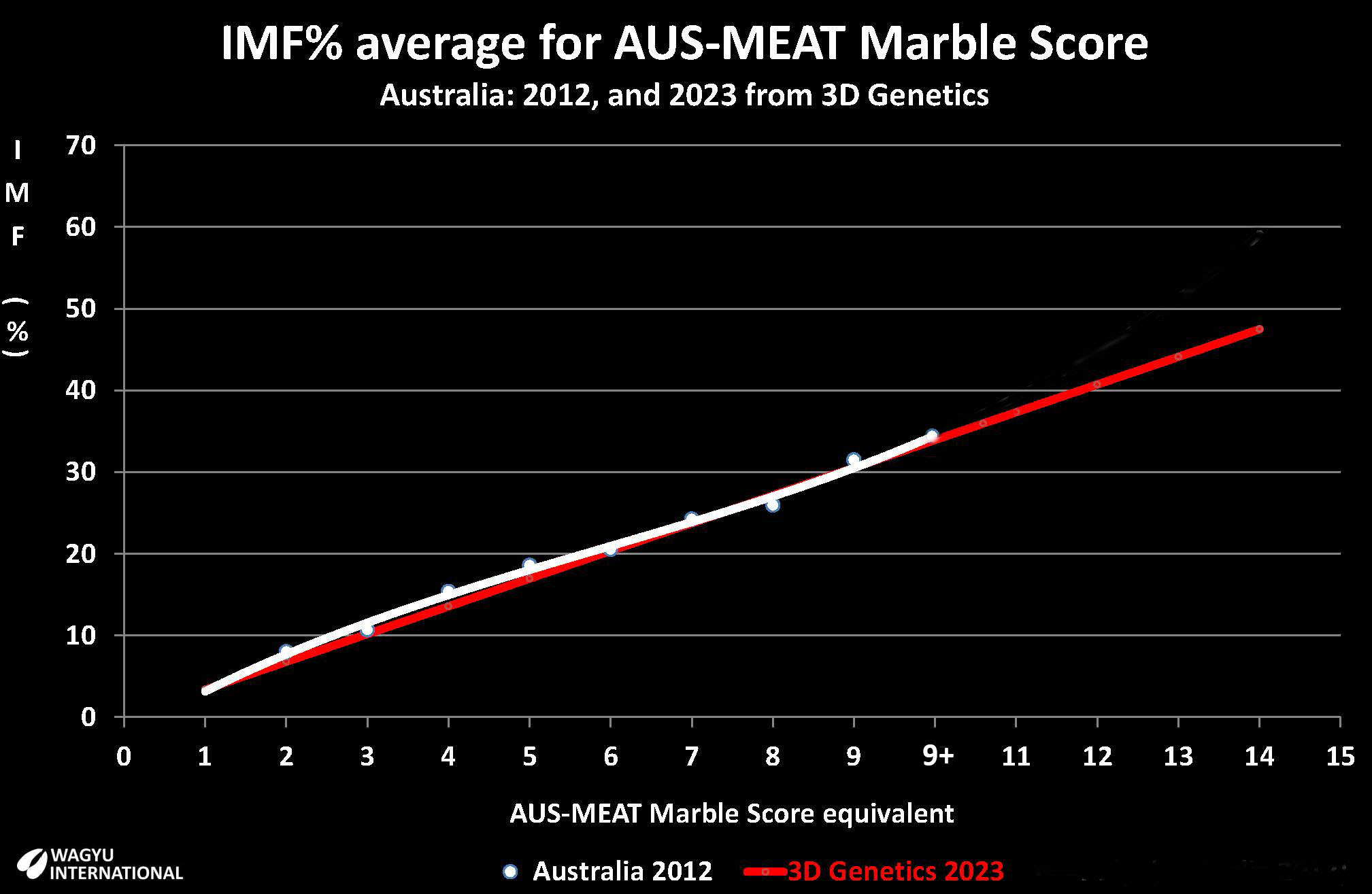
Highest quality 100% pure Australian fullblood Wagyu beef is available from export to Japan and USA.
Genetic evaluation
"To bring genetic gain, the phenotype needs to be measured accurately".
Inconsistency within the grading system to evaluate marbling through the full spectrum of production in Wagyu in Australia led Dr Joe Grose, President of the Australian Wagyu Association, to introduce carcass digital imaging. Despite a backlash from a handful of sceptics, this technology replaced conventional ultrasound scanning which only had an accuracy of 30% for measuring marbling in Wagyu.
In 2014, the AWA released the first Research EBVs after the analysis of the first 2,000 carcasses by AGBU/ABRI. A year later, the carcass EBVs are incorporated into Wagyu BREEDPLAN during the monthly runs and they became used together with EBVs for growth, birth weight and fertility traits that had been generated for 30 years by BREEDPLAN.
A paper by Sakura Maeda showed how heritability of Marble Score almost doubled in Australia from 0.23 to 0.54 when IMF% from digital analysis using the camera to measure marbling instead of the official AUS-MEAT Marble Score. There will be two different constraints. Firstly the inaccuracies from Marble Score grades is impairing the accuracy of quantifying marbling. An example of the huge overlap in Marble Score scores, the lowest IMF% from a carcass graded 9+, is lower than the highest IMF% for a carcass graded Marble Score 4. In other words, individuals with 25 IMF% have been graded over seven different scores - from MS 4, 5, 6, 7, 8, 9 and 9+. Secondly, at least 30% of Fullblood Wagyu marble above 9+ so the most valuable genetics cannot be differentiated and quantified by the official grading scheme. Prof Ben Hayes at the AWA AGM technical workshop in 2017 reported the validation accuracy of Marbling Score of David Blackmore of 0.43 is low and explained that this is due to the limitations of relying on AUS-MEAT Marble Score. It is higher for easier to measure traits such as Eye Muscle Area which has a validation accuracy of 0.57.
Co-funding from MLA accelerated progress and Single Step BLUP analysis was introduced into Australian BreedPlan.
Pricing for Wagyu beef
The pricing grid is determined by the AUS-MEAT marble score and varies between processors but some market prices are:
| AUS-MEAT marble score | $ per kilogram |
|---|---|
| 3 | $5.00-$6.00 |
| 4 | $6.00-$7.00 |
| 5 | $7.00-$8.00 |
| 6 | $7.50-$8.50 |
| 7 | $8.50-$9.50 |
| 8 | $9.50-$10.50 |
| 9 | $11.50-$12.50 |
| 9+ | $12.50-$13.50 |
Wholesale price of loin cuts: Fullblood 100% $80-$130 and Wagyu crossbred $40-$8
Retail price for 5 kilograms F1 rump marble score 4-5 is $20, and $49 per kilogram as single steaks.
Truth in labelling: Wagyu content
The Australian Wagyu Association announced the Wagyu breed trade description which has been endorsed by the Australian Meat Industry Language and Standards Committee. It is recommended for use by the industry:
WAGYU FULLBLOOD 100%: The offspring of a Wagyu Fullblood sire and a Wagyu Fullblood dam whose forebears originate from Japan and whose pedigree shows no evidence of crossbreeding.
WAGYU PUREBRED F4 (93+%): Greater than 93% Wagyu content and the result from at least four generations of crossbreeding with a Wagyu Fullblood sire.
WAGYU CROSSBRED F3 (87+%): Greater than 87% Wagyu content and the result from at least three generations of crossbreeding with a Wagyu Fullblood sire.
WAGYU CROSSBRED F2 (75%): Has 75% or higher content and the result from at least two generations of crossbreeding with a Wagyu Fullblood sire.
WAGYU CROSSBRED F1 (50%): Has 50% or higher Wagyu content and the first generation of crossbreeding with a Wagyu Fullblood sire.
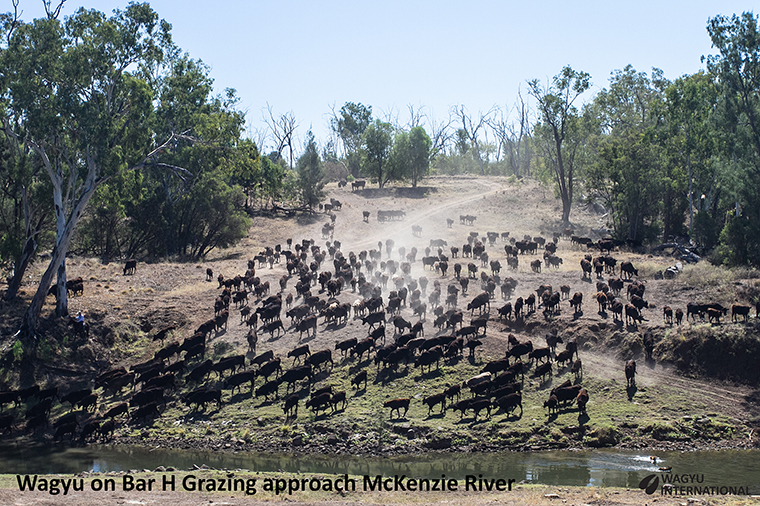
Australian Consumer Law is upheld by the Australian Competition and Consumer Commission (ACCC) and they carried out an investigation of Waguyu beef. The matter appeared to have been resolved when the Wagyu breed trade descriptor was published by the AWA. However it needs to be implemented through the market.
World Wagyu Conference
The first International Wagyu Conference in Australia was held on the Gold Coast in Queensland in 2000.
The next "World Wagyu Conference" was held in Yepoon, near Rockhampton in Queensland after Beef Week from May 8-10, 2015.
It was agreed that the next world conference would be held after two years, and then in South Africa another two years later.
